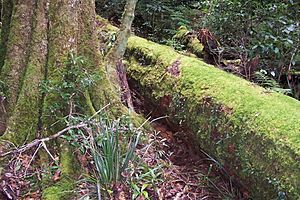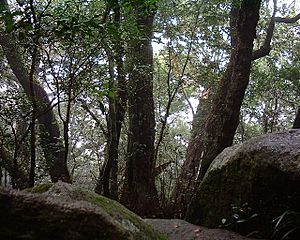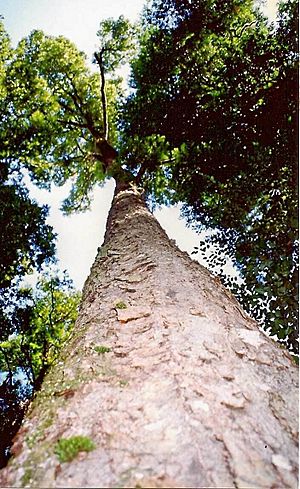Antarctic beech facts for kids
Quick facts for kids Antarctic beech |
|
|---|---|
 |
|
| Comboyne, Australia | |
| Scientific classification | |
| Genus: |
Nothofagus
|
| Species: |
moorei
|
| Synonyms | |
|
Lophozonia moorei |
|
The Antarctic beech (scientific name: Nothofagus moorei) is a special type of tree. It's like a living fossil from an ancient supercontinent called Gondwana. You can find it in wet, high-up rainforests in eastern Australia.
This tree belongs to a very old family called Nothofagaceae. Trees from this family grow in places like southern South America (Chile, Argentina) and Australasia (Australia, New Zealand, New Guinea, and New Caledonia). This shows how old and spread out these trees are!
Contents
Discovering the Antarctic Beech
Who Named It?
A scientist named Ferdinand von Mueller first described the Antarctic beech in 1866. He studied samples collected by Charles Moore near the Bellinger River.
Changing Names
This tree was once called 'negrohead beech'. Now, it's known as 'Antarctic beech'. It's important not to confuse it with a similar tree from South America, Nothofagus antarctica. The Antarctic beech is an evergreen tree. This means it keeps its leaves all year round.
In 2013, some scientists suggested changing its scientific name from Nothofagus moorei to Lophozonia moorei. This name change is still being discussed.
Family Tree
The Antarctic beech is related to two other evergreen trees. One is the silver beech (N. menziesii) from New Zealand. The other is the myrtle beech (N. cunninghamii) from Tasmania and Victoria.
What Does the Antarctic Beech Look Like?
Size and Bark
These trees usually grow about 25 meters (80 feet) tall. Their trunks can be as wide as 1 meter. The bark is dark brown and scaly. Some very tall trees can reach up to 50 meters!
Leaves and Flowers
The leaves are simple and grow in an alternating pattern. They are about six centimeters long. The leaves are dark green, but new leaves in spring are bright red or orange. In its natural home, the tree drops some of its leaves in autumn. The leaves are shaped like triangles or oblongs. They have small teeth along their edges.
The Antarctic beech has both male and female flowers on the same tree. These flowers are small and hard to see. They grow in tiny groups near the leaves.
Fruit and Seeds
The tree produces fruit from December to February. The fruit is a small, woody pod with four prickly parts. Inside each fruit, there are three small, winged nuts.
Roots and Fire
Antarctic beech trees often have amazing root systems. These roots were once underground. Over time, erosion has exposed them. Now, they are often covered in moss and lichen. Many trees have several trunks growing from one main root crown.
Fires are very bad for the Antarctic beech. Unlike many other Australian plants, this tree takes a long time to recover after a fire.
Where Do Antarctic Beeches Grow?
The Antarctic beech grows in cool, wet rainforests. You can find them from the Barrington Tops plateau in New South Wales up to the Lamington Plateau and Springbrook Plateau in southern Queensland. They grow at heights between 480 meters and 1550 meters above sea level. These areas have cool temperatures and sometimes get snow. The best places to see these trees are Werrikimbe National Park and Mount Banda Banda.
The Comboyne Population
There are four known groups of Antarctic beech trees in the Comboyne area of New South Wales. In 1925, a botanist named E.C. Chisholm said these trees were "extremely rare." Many trees were cut down when the Comboyne Plateau was cleared between 1900 and 1925.
The Comboyne plateau is a flat area with steep edges. It sits between the Mid North Coast of New South Wales and the Great Dividing Range. The soil here is rich and red-brown. The climate is wet and subtropical, but it can get frost and even snow.
Scientists once thought the Comboyne population of Antarctic beech might be gone. But in 1994, botanists Bale and Williams found them. These trees are growing well from seeds. Many young plants are found there.
This is one of the few places where Antarctic beeches grow at lower altitudes (as low as 570 meters). Another is near Dorrigo. The rainforest expert Alexander Floyd considers the Comboyne trees to be a special type of cool temperate rainforest.
A Look Back in Time

Many Antarctic beech trees are incredibly old, some around 12,000 years old! People once thought that these trees in eastern Australia could not reproduce by seeds. They believed the trees only grew new shoots from their roots. This made scientists think they were leftovers from a much cooler time.
However, we now know they can reproduce using seeds. But they still mostly grow in cool, isolated, high-altitude places. This fits the idea that the species was more common when the Earth was colder.
The way these trees are spread around the southern Pacific Ocean suggests something amazing. It supports the idea that the genus dates back to when Antarctica, Australia, and South America were all connected. This huge landmass was called Gondwana.

The Antarctic beech is also a beautiful tree for gardens. Cultivated trees can handle cold temperatures down to -7°C (19°F). Wild plants on Barrington Tops have even survived record lows of -17°C (1°F)!
Images for kids
-
Antarctic beech at Mount Banda Banda
-
Antarctic beech trees in Numinbah Nature Reserve




